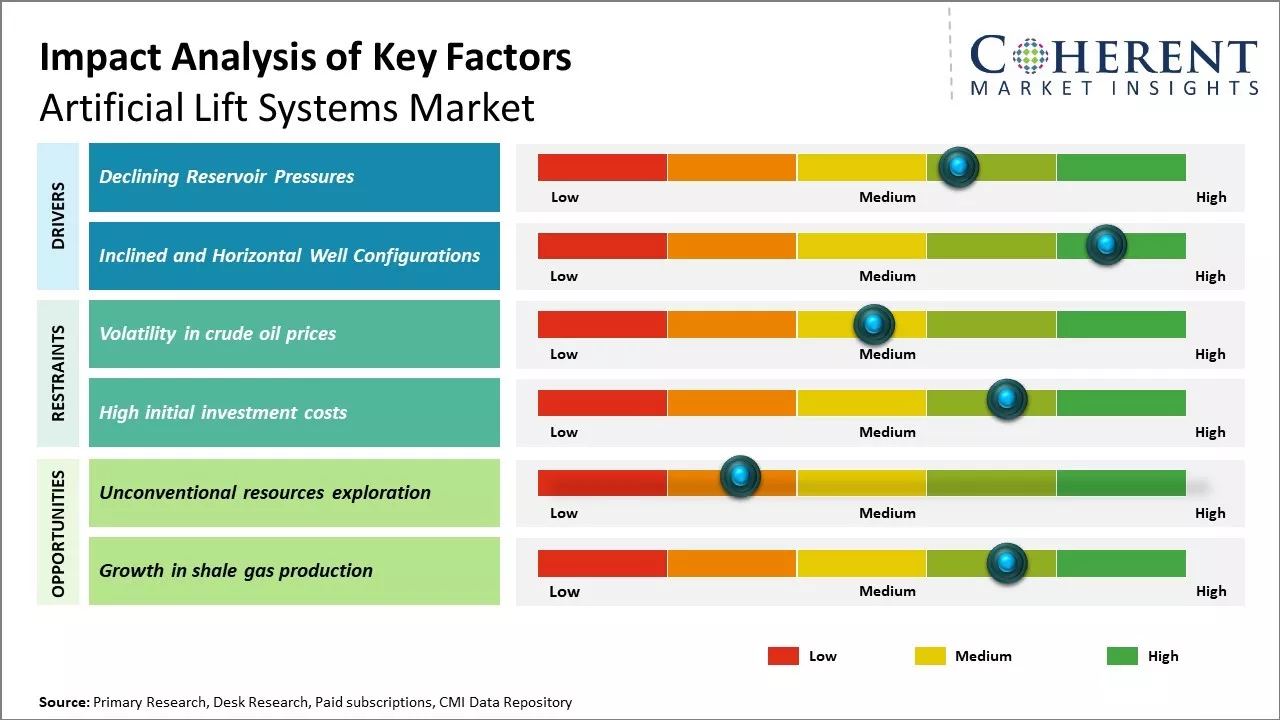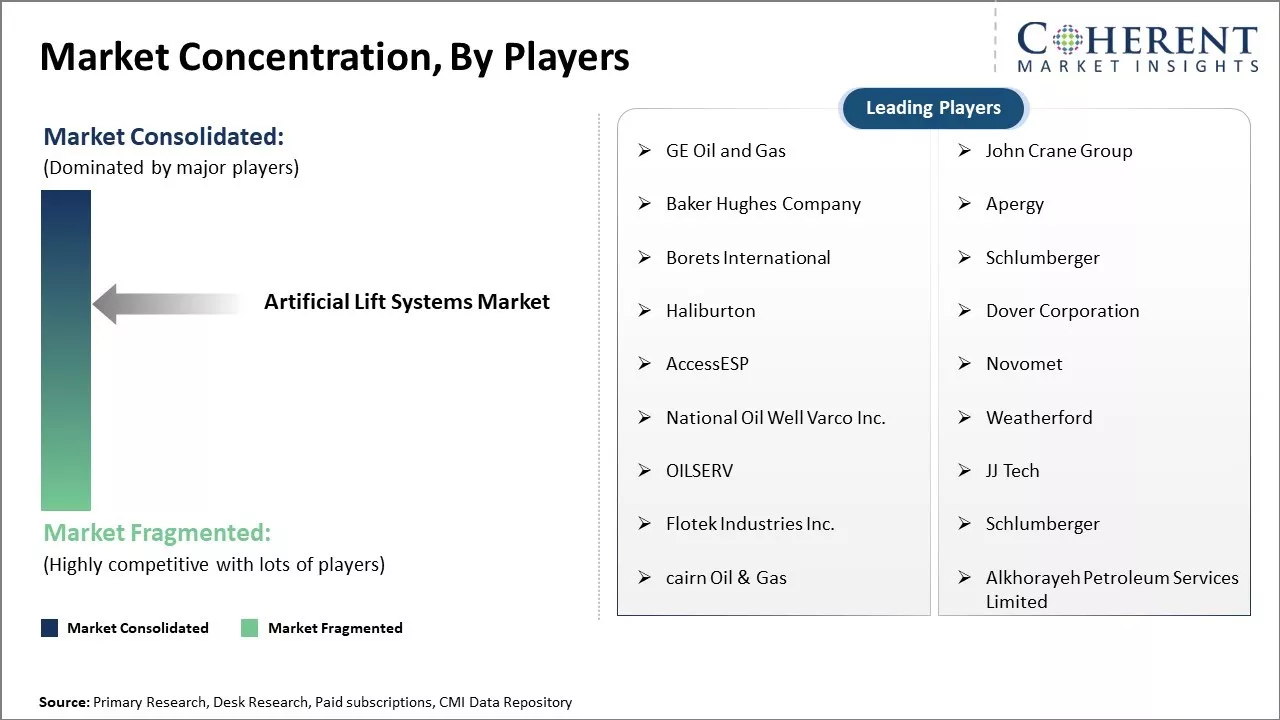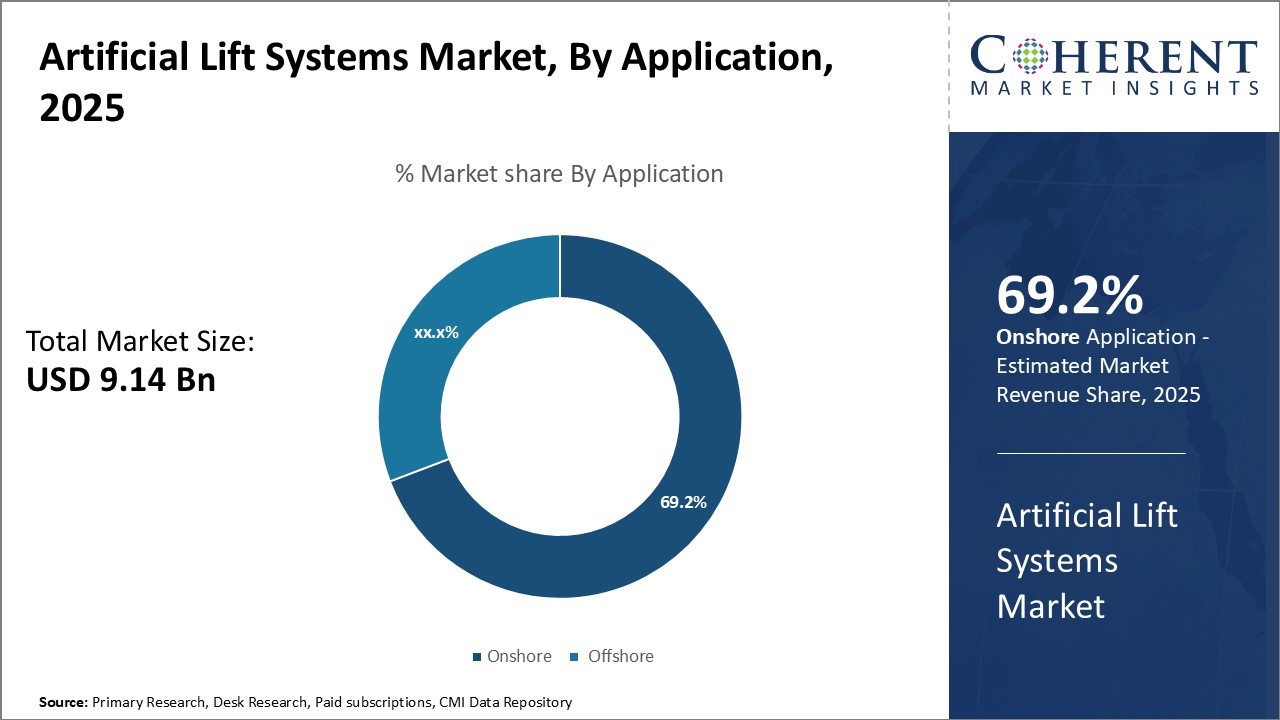Artificial Lift Systems Market Size and Forecast – 2025 to 2032
Global artificial lift systems market is estimated to be valued at USD 9.14 Bn in 2025 and is expected to reach USD 15.67 Bn by 2032, exhibiting a compound annual growth rate (CAGR) of 8.0% from 2025 to 2032.
Key Takeaways
- By Application, offshore acquired the prominent share of 69.2% in 2025 as expansion of offshore & deepwater exploration.
- By Component, Pump dominates the overall market with an estimated share of 37.9% in 2025 owing to the declining reservoir pressure & mature fields.
- By Lift Type, Electric Submersible Pumps hold the largest market share of 30% in 2025 owing to its declining reservoir pressure & mature field revitalization.
- By Mechanism, Pump Assisted dominates the overall market in 2025 owing to the declining reservoir pressure in mature wells.
- By Region, North America hold the largest market share of 38.8% in 2025 owing to its proliferation of shale & unconventional plays.

To learn more about this report, Download Free Sample
Market Overview
Growing oil & gas production across the globe and increasing number of mature oilfields boosts artificial lift systems market demand. Many large oilfields are now in the mature phase of production and require artificial lift systems to propel the oil towards the surface. The shift towards unconventional resources such as tight oil and shale gas that require artificial lift techniques to produce the resources profitably can drive the growth of artificial lift systems market.
Current Events and their Impact on the Artificial Lift Systems Market
|
Current Events |
Description and its impact |
|
OPEC+ Production Strategy and Output Policy Changes |
|
|
Red Sea Shipping Crisis and Maritime Disruptions |
|
|
Global Energy Demand Volatility and Trade Policy Impacts |
|
Uncover macros and micros vetted on 75+ parameters: Get instant access to report
End-user Feedback and Unmet Needs in the Artificial Lift Systems Market
- Demand for Increased System Reliability: End-users emphasize the need for artificial lift systems with higher reliability and longer service life to minimize costly downtime. Frequent equipment failures disrupt production schedules, leading operators to seek more robust designs and improved materials that withstand harsh reservoir conditions and reduce maintenance frequency.
- Integration of Advanced Monitoring: Operators express a strong desire for better integration of real-time monitoring and automation technologies. End-users want systems that provide actionable insights through predictive analytics, enabling proactive maintenance and operational efficiency. Current solutions sometimes lack seamless data connectivity and user-friendly interfaces.
- Customization for Diverse Reservoirs: Users highlight a gap in lift systems tailored to specific reservoir characteristics, including variations in fluid properties and pressure conditions. There is a need for more flexible, adaptable artificial lift technologies that can be easily customized to unique well environments for optimal performance.
Role of AI (Artificial Intelligence) in Artificial Lift Systems
Artificial intelligence is revolutionizing the artificial lift systems market by enabling real-time optimization, predictive maintenance, and advanced production forecasting. AI technologies such as machine learning and digital twins enhance system efficiency by minimizing downtime, reducing energy consumption, and improving recovery rates. These tools help operators adjust lift performance dynamically, detect equipment failures early, and make data-driven decisions.
In June 2025, Baker Hughes, an energy technology firm, and Repsol, a global multi-energy company, announced a partnership to implement advanced digital technologies using the Leucipa™ automated field production solution, which includes a generative AI-driven virtual assistant. Repsol is currently testing the Leucipa Lift Optimizer—an AI-enhanced tool designed for plunger lift wells—to improve field operations and substantially cut down the time its production engineers spend on monitoring, managing, and maintaining individual wells.
Artificial Lift Systems Market Insights, By Application: Offshore contribute the highest share of the market owing to its technological advancements and smart automation
Offshore segment is estimated to contribute the highest market share owing 69.2% in 2025. As offshore oil wells has higher reservoir pressures as compared to onshore wells, artificial lift systems play a crucial role in efficiently extracting oil and gas from these reservoirs. Many leading oil producing countries such as the U.S., Brazil, Norway and Malaysia have made large investments in offshore exploration over the past decade, and this has boosted demand for various offshore artificial lift solutions. Offshore operations present unique challenges such as harsh weather conditions, remote locations and water depth that require specialized equipment. Subsea pumps and modular pump systems are widely used as these can withstand high pressures and temperatures underwater. Multiphase pump technology has gained popularity as it can extract a mixture of oil, gas and water in one flow stream without separation. For instance, in April 2024, SLB introduced two advanced artificial lift systems: the Reda™ Agile™ compact wide-range electric submersible pump (ESP) system and the rodless Reda PowerEdge™ electric submersible progressing cavity pump (ESPCP) system. Pertamina deployed the Agile ESP system to produce from a 6,000-ft well offshore Indonesia after three conventional ESPs failed, causing USD 600,000 in production deferments and workover costs, further proliferating the artificial lift systems market share.
Artificial Lift Systems Market Insights, By Component: Pump contribute the highest share of the market owing to its growth in unconventional production
The pump segment is estimated to contribute the highest share owing 37.9% in 2025. As reservoirs age, fluid flows cannot be supported by natural reservoir pressures alone, thus, ESPs play a key role in overcoming the effects of declining reservoir energies through artificial fluid pressurization using downhole motors. Their closed pumping system makes them apt for handling fluids with gas, solids and waxes. A majority of older onshore oilfields in North America and the Middle East rely on ESPs for primary, secondary or tertiary recovery after substantial past production. As natural reservoir drive progressively decreases, ESPs enable efficient extraction of remaining oil by working closely with reservoir characteristics. This helps maximize the ultimate recovery from older assets and extend their economic lives. In addition, mature offshore reservoirs around Southeast Asia, Africa and Latin America have boosted investments in ESP deployment plans to arrest production declines. For instance, in July 2025, Oman has boldly advanced its goal of becoming a regional manufacturing hub for artificial lift systems by successfully producing the first Long Stroke Pump Unit (LSU) entirely within the Gulf Cooperation Council (GCC).
Artificial Lift Systems Market Insights, By Lift Type: Electric Submersible Pumps contribute the highest share of the market owing to rapid expansion of unconventional & deepwater production
Electric Submersible Pumps segment is estimated to contribute the highest market share due owing 30% in 2025. Shale reservoirs typically involve low permeability and require artificial lift much earlier during production lifecycle compared to conventional reservoirs. ESPs emerge as a primary selection owing to their versatility in handling multiphase flows and solids-laden fluids common to shale reservoirs. In the U.S., shale formations like Bakken, Permian and Eagle Ford have mainly relied on ESPs to lift oil rapidly to surface from horizontal wellbores. As shale production escalated over the last decade, ESP manufacturers consistently upgraded product ranges to tackle unique challenges of shale like high solids content, scaling and wax deposition issues. Dedicated ESP models with advanced fluid handling, seal barrier systems and temperature rated pumps cater to highly deviated and extended reach wells. For instance, in February 2025, ChampionX redesigned its LOOKOUT™ optimization services for electrical submersible pumping (ESP) systems. The enhanced service delivers real-time data, full system control, advanced data visualization, integrated communications, and direct access to a team of multi-disciplined artificial lift experts.
Artificial Lift Systems Market Insights, By Mechanism: Pump Assisted contribute the highest share of the market owing to its technology & monitoring advancements
Aging oilfields with declining reservoir pressure drive the demand for pump-assisted artificial lift systems. Operators increasingly deploy technologies like electric submersible pumps and progressive cavity pumps in both conventional and unconventional wells for their ability to manage high flow rates and harsh conditions. Advancements in automation, remote monitoring, and energy-efficient designs further boost their adoption. Their flexibility in onshore and offshore applications strengthens their role as essential tools in sustaining and optimizing global oil production.
Regional Insights

To learn more about this report, Download Free Sample
North America Artificial Lift Systems Market Trends
North America leads in adopting artificial lift systems, driven by growing shale production in the Permian, Bakken, and Eagle Ford basins and efforts to redevelop mature oilfields. Operators increasingly choose electric submersible pumps, gas-assisted lifts, and hybrid technologies that merge multiple methods. Offshore projects, continue to gain momentum. Companies are prioritizing automation, real-time monitoring, energy-efficient solutions, and predictive maintenance.
For instance, Novomet, an international oilfield services company, launched a new website to showcase its products and services to oil and gas producers worldwide. The company continues to expand its presence in key global markets as a provider of artificial lift technology for hydrocarbon production.
Asia Pacific Artificial Lift Systems Market Trends
Operators in India, China, Indonesia, and Malaysia are actively retrofitting aging onshore and offshore oilfields with rod lift, ESP, gas lift, and hybrid systems to combat declining reservoir pressures and increasing water cuts. For instance, China Petroleum Network News reported that the multi-stage gas lift valve coiled tubing gas lift technology, independently developed by the Tuha Gas Lift Technology Center, has been running smoothly for 200 days in the Shengbei 506H well at Tuha Oilfield. This achievement marks the world’s first successful well test of a multi-stage gas lift valve system using coiled tubing. Governments encourage these efforts by offering extended PSC terms and tax incentives. Additionally, oil companies are implementing smart lift technologies, such as intelligent ESPs combined with real-time digital monitoring and predictive analytics, to reduce energy consumption, prolong equipment lifespan, and cut operating costs.
United States Artificial Lift Systems Market Trends
Offshore oil and gas projects, including BP’s Herschel Expansion in the Gulf of Mexico, drive demand for artificial lift systems such as gas lifts and electric submersible pumps (ESPs). These systems help operators boost production from deepwater reserves and complex subsea environments. Operators also adopt automation and remote monitoring technologies, using real-time data analytics and predictive maintenance to minimize downtime, optimize performance, save costs, and improve operational efficiency.
India Artificial Lift Systems Market Trends
Aging oilfields in Gujarat and Mumbai are driving operators in India to shift toward electric submersible pumps (ESPs). These systems boost production by addressing declining output from maturing fields. As exploration activities increase, companies are adopting more ESPs, supported by rising investments. Government policies, including auctions of small discovered fields and enhanced oil recovery projects, actively promote artificial lift system growth by encouraging mature field development and advanced technology adoption.
Market Concentration and Competitive Landscape

To learn more about this report, Download Free Sample
Artificial Lift Systems Market News
- In March 2025, Pakistan’s Oil & Gas Development Company Limited (OGDCL) restored production at the heavy oil well Rajian-11 by installing an advanced air lift system. OGDCL fully owns and operates the oil field, located in District Chakwal, under the Gujar Khan E.L.
- In January 2025, Flowco Holdings Inc. (“Flowco”), a provider of production optimization, artificial lift, and methane abatement solutions for the oil and natural gas industry, launched its proposed initial public offering of 17,800,000 shares of its Class A common stock, following the filing of a registration statement on Form S-1 with the U.S. Securities and Exchange Commission (SEC).
- In March 2024, Silverwell Technology Inc. expanded its digital intelligent artificial lift (DIAL) gas lift production optimization system into Africa by winning a contract with a major operator offshore Nigeria.
Market Report Scope
Artificial Lift Systems Market Report Coverage
| Report Coverage | Details | ||
|---|---|---|---|
| Base Year: | 2024 | Market Size in 2025: | USD 9.14 Bn |
| Historical Data for: | 2020 To 2024 | Forecast Period: | 2025 To 2032 |
| Forecast Period 2025 to 2032 CAGR: | 8.0% | 2032 Value Projection: | USD 15.67 Bn |
| Geographies covered: |
|
||
| Segments covered: |
|
||
| Companies covered: |
GE Oil and Gas , John Crane Group , Baker Hughes Company , Apergy , Borets International , Schlumberger , Haliburton , Dover Corporation , AccessESP , Novomet , National Oil Well Varco Inc. , Weatherford , OILSERV , JJ Tech , Flotek Industries Inc. , Schlumberger , cairn Oil & Gas, Alkhorayeh Petroleum Services Limited |
||
| Growth Drivers: |
|
||
| Restraints & Challenges: |
|
||
Uncover macros and micros vetted on 75+ parameters: Get instant access to report
Artificial Lift Systems Market Trend
- Growing Adoption of Electric Submersible Pumps (ESPs)
Electric submersible pumps (ESPs) are increasingly preferred due to their ability to handle high volumes and depths. Operators use ESPs to maximize production from both mature and unconventional wells. Advancements in materials and design improve reliability and efficiency. Integration with smart monitoring systems enables real-time performance tracking, reducing downtime. This technology’s scalability makes it suitable for various well conditions, driving widespread adoption across onshore and offshore fields worldwide.
In July 2025, Shakti Pumps India Limited, introduced a new 4-inch Plug and Play Submersible Pump. This innovative solution is engineered to deliver enhanced efficiency while minimizing operating costs, and it functions without requiring a separate control box.
Artificial Lift Systems Market Opportunity
- Expansion in Mature Field Revitalization
As many oilfields age, operators face declining natural reservoir pressures that reduce production. This creates significant opportunities for artificial lift technologies to extend field life and improve recovery rates. Companies can offer advanced lift solutions tailored to aging reservoirs, combining retrofit capabilities with automation and monitoring to maximize output while reducing operational costs and downtime.
Analyst Opinion (Expert Opinion)
- The Artificial Lift Systems Market is undergoing a pivotal transformation driven by technological innovation and shifting operational priorities. From my analysis, the most critical trend reshaping the sector is the aggressive integration of digital technologies—particularly real-time monitoring and predictive analytics—which fundamentally changes how operators approach well productivity and maintenance.
- Moreover, the move toward energy-efficient lift solutions is no longer optional—it is imperative. With electric submersible pumps (ESPs) accounting for nearly 70% of the artificial lift deployments in the U.S. shale plays, companies are aggressively investing in variable speed drives and hybrid systems that reduce power consumption while enhancing flow rates. Baker Hughes recently reported a 15% drop in energy costs after deploying advanced ESPs with integrated automation in the Permian Basin, underscoring the financial and environmental stakes tied to efficiency.
- Offshore and deepwater applications reveal another layer of complexity. The Gulf of Mexico’s growing deepwater activity demands artificial lift systems that can withstand extreme pressure and corrosive environments. Halliburton’s recent deployment of advanced gas lift valves capable of withstanding pressures above 15,000 psi sets a new benchmark for subsea reliability. Such innovations are crucial as operators seek to extract value from increasingly challenging reservoirs.
Market Segmentation
- Application Insights (Revenue, USD Bn, 2020 - 2032)
- Onshore
- Offshore
- Component Insights (Revenue, USD Bn, 2020 - 2032)
- Pump
- Motor
- Cable System
- Controller
- Others
- Lift Type Insights (Revenue, USD Bn, 2020 - 2032)
- Pressurized Water Reactor (PWR)
- Electric Submersible Pumps
- Gas lift
- Progressing Cavity Pumps
- Jet pump
- Others
- Mechanism Insights (Revenue, USD Bn, 2020 - 2032)
- Pump Assisted
- Gas Assisted
- Regional Insights (Revenue, USD Bn, 2020 - 2032)
- North America
- U.S.
- Canada
- Latin America
- Brazil
- Argentina
- Mexico
- Rest of Latin America
- Europe
- Germany
- U.K.
- France
- Italy
- Russia
- Rest of Europe
- Asia Pacific
- China
- India
- Japan
- Australia
- South Korea
- ASEAN
- Rest of Asia Pacific
- Middle East & Africa
- GCC Countries
- South Africa
- Rest of Middle East & Africa
- Key Players Insights
- GE Oil and Gas
- John Crane Group
- Baker Hughes Company
- Apergy
- Borets International
- Schlumberger
- Haliburton
- Dover Corporation
- AccessESP
- Novomet
- National Oil Well Varco Inc.
- Weatherford
- OILSERV
- JJ Tech
- Flotek Industries Inc.
- Schlumberger
- cairn Oil & Gas
- Alkhorayeh Petroleum Services Limited
Sources
Primary Research Interviews
- Industry experts from oil and gas operators
- Field engineers specializing in artificial lift systems
- Technology manufacturers and service providers
Databases
- U.S. Energy Information Administration (EIA)
- International Energy Agency (IEA)
- Petroleum Intelligence Weekly (PIW)
- Offshore Technology Reports
Magazines
- Oil & Gas Journal
- World Oil Magazine
- Offshore Engineer
- Petroleum Economist
Journals
- Journal of Petroleum Technology
- SPE Production & Operations
- Journal of Energy Resources Technology
- Petroleum Science and Technology
Newspapers
- Financial Times (Energy Section)
- The Wall Street Journal (Energy & Oil)
- Reuters Energy News
- Bloomberg Energy
Associations
- Society of Petroleum Engineers (SPE)
- American Petroleum Institute (API)
- International Association of Oil & Gas Producers (IOGP)
- Offshore Technology Conference (OTC)
Public Domain Sources
- U.S. Department of Energy Reports
- National Petroleum Council Publications
- Government energy ministry reports (India, Canada, Australia)
- Publicly available company annual reports and investor presentations
Proprietary Elements
- CMI Data Analytics Tool, and Proprietary CMI Existing Repository of information for last 8 years
Share
Share
About Author
Monica Shevgan has 9+ years of experience in market research and business consulting driving client-centric product delivery of the Information and Communication Technology (ICT) team, enhancing client experiences, and shaping business strategy for optimal outcomes. Passionate about client success.
Missing comfort of reading report in your local language? Find your preferred language :
Transform your Strategy with Exclusive Trending Reports :
Frequently Asked Questions
EXISTING CLIENTELE
Joining thousands of companies around the world committed to making the Excellent Business Solutions.
View All Our Clients

